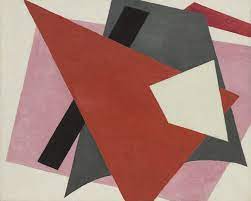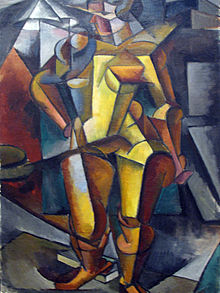Borëd | Artist Spotlight | Lyubov Popova
- Bored B.B

- Sep 15, 2021
- 2 min read
Lyubov Sergeyevna Popova was a Russian avant-garde artist (Cubist, Suprematist and Constructivist), painter and designer. Popova was born in Ivanovskoe, near Moscow, to the wealthy family of Sergei Maximovich Popov, a very successful textile merchant and vigorous patron of the arts, and Lyubov Vasilievna Zubova, who came from a highly cultured family.
Popova grew up with a strong interest in art, especially Italian Renaissance painting. At eleven years old she began formal art lessons at home; she was first enrolled in Yaltinskaia's Women's Gymnasium, then in Arseneva's Gymnasium in Moscow. By the age of 18 she was studying with Stanislav Zhukovsky, and in 1908 entered the private studios of Konstantin Yuon and Ivan Dudin. In 1912 to 1913, she began attending the studios of the Cubist painters Henri Le Fauconnier and Jean Metzinger at Académie de La Palette in Paris.
Popova was one of the first female pioneers in Cubo-Futurism. Through a synthesis of styles she worked towards what she termed painterly architectonics. After first exploring Impressionism, by 1913, in Composition with Figures, she was experimenting with the particularly Russian development of Cubo-Futurism: a fusion of two equal influences from France and Italy.
Her painting The Violin of 1914 suggests the development from Cubism towards the "painterly architectonics" series of 1916–1918. This series defined her distinct artistic trajectory in abstract form. The canvas surface is an energy field of overlapping and intersecting angular planes in a constant state of potential release of energy. At the same time the elements are held in a balanced and proportioned whole as if linking the compositions of the classical past to the future. Color is used as the iconic focus; the strong primary color at the center drawing the outer shapes together. Popova's superimposed planes and strong color have the objective presence of actual space and materials.
As early as 1917, in parallel with her Suprematist work, the artist had made fabric designs and worked on Agitprop books and posters, In the Tenth State Exhibition: Non Objective Creativity and Suprematism, 1918, she contributed the architectonic series of paintings. She continued painting advanced abstract works until 1921. In 1923 she began creating designs for fabric to be manufactured by the First State Textile Printing Works in Moscow. From 1921 to 1924 Popova became entirely involved in Constructivist projects, sometimes in collaboration with Varvara Stepanova, the architect Alexander Vesnin and Alexander Rodchenko.
Popova died at the peak of her artistic powers two days after the death of her son, from whom she had contracted scarlet fever in 1924 in Moscow at age 35. A large exhibition of her work opened in Moscow from December 21, 1924 to January 1925, at Stroganov Institute, Moscow. The exhibition included Popova's works such as seventy-seven paintings, as well as books, posters, textile designs, and line engravings. "Artist-Constructor" was the term applied to Popova by her contemporaries in the catalogue of the artist's posthumous exhibition.
Come back next week to see the next artist in the spotlight!
Enjoy the art. Stay bored 🖤




















Comments